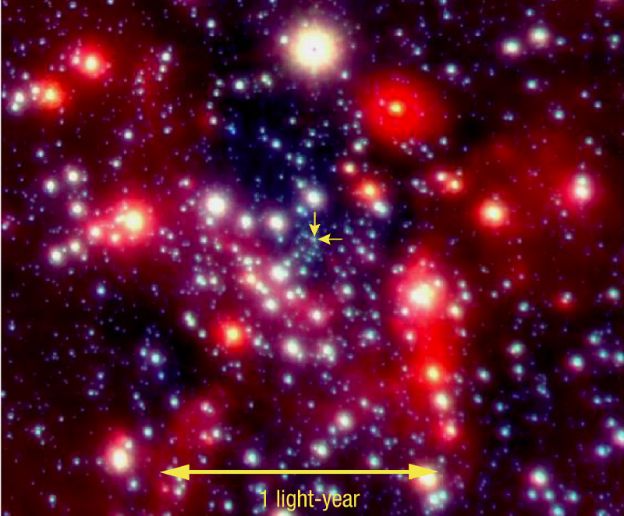
|
Explanation: At the center of our Milky Way Galaxy lies a black hole with over 2 million times the mass of the Sun. Once a controversial claim, this astounding conclusion is now virtually inescapable and based on observations of stars orbiting very near the galactic center. Using one of the Paranal Observatory's very large telescopes and the sophisticated infrared camera NACO, astronomers patiently followed the orbit of a particular star, designated S2, as it came within about 17 light-hours of the center of the Milky Way (17 light-hours is only about 3 times the radius of Pluto's orbit). Their results convincingly show that S2 is moving under the influence of the enormous gravity of an unseen object which must be extremely compact -- a supermassive black hole. This deep NACO near-infrared image shows the crowded inner 2 light-years of the Milky Way with the exact position of the galactic center indicated by arrows. NACO's ability to track stars so close to the galactic center can accurately measure the black hole's mass and perhaps even provide an unprecedented test of Einstein's theory of gravity as astronomers watch a star orbit a supermassive black hole.
|
January February March April May June July August September October November December |
| ||||||||||||||||||||||||||||||||||||||||||||||||
NASA Web Site Statements, Warnings, and Disclaimers
NASA Official: Jay Norris. Specific rights apply.
A service of: LHEA at NASA / GSFC
& Michigan Tech. U.
Based on Astronomy Picture
Of the Day
Publications with keywords: Milky Way - Galactic Center - black hole
Publications with words: Milky Way - Galactic Center - black hole
See also:
- APOD: 2025 December 3 ┴ Visualization: Near a Black Hole and Disk
- APOD: 2025 September 24 ┴ GW250114: Rotating Black Holes Collide
- APOD: 2025 July 2 ┴ Milky Way Through Otago Spires
- APOD: 2025 May 20 ┴ Milky Way over Maunakea
- APOD: 2025 May 13 ┴ Gaia Reconstructs a Top View of our Galaxy
- APOD: 2025 May 12 ┴ Gaia Reconstructs a Side View of our Galaxy
- APOD: 2025 May 9 ┴ IXPE Explores a Black Hole Jet
